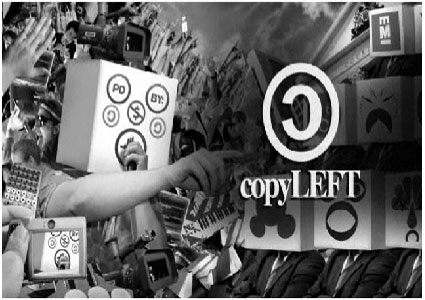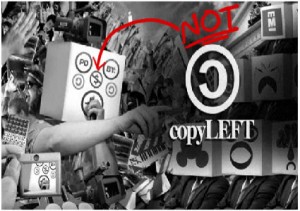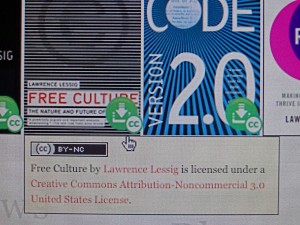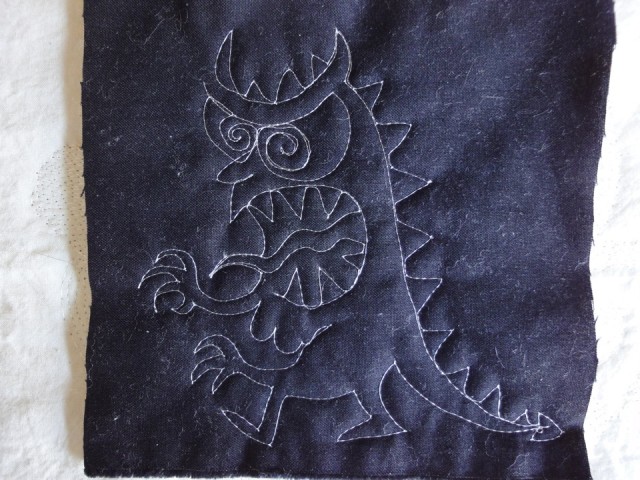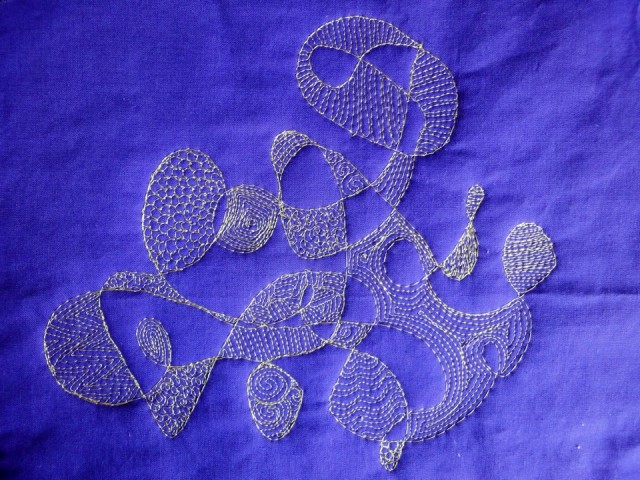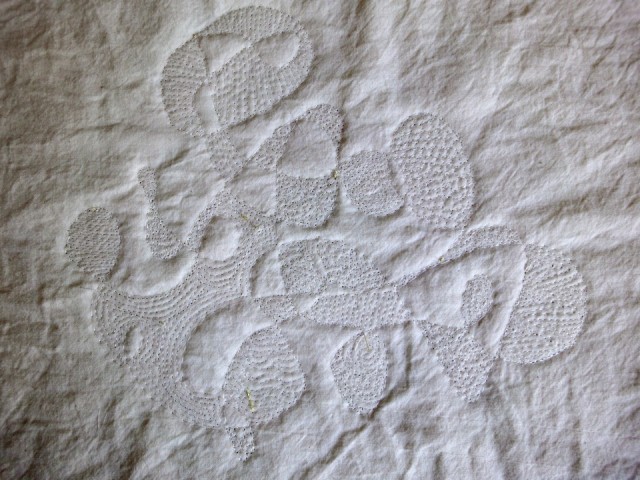Economists talk about rivalrous and non-rivalrous goods, but Culture is neither rivalrous, nor non-rivalrous; it is anti-rivalrous.
I. Rivalrous
Rivalrous goods diminish in value the more they are used. For example, a bicycle: if I use it, it gets me from here to there, if you use it, it gets me nowhere. If I acquire your bicycle, you don’t have it any more. Only one of us can have the bicycle at one time. We can share it to a limited extent, but the more it’s used the less it’s worth; it gets dinged up and wears out. The more people use the bicycle, the less utility it has.

All material things – things made of atoms – are rivalrous, because an object cannot be in two places at the same time. Everything in the physical world is rivalrous, even if it’s abundant.
A commons is a rivalrous good. Hence the “tragedy of the commons“: the more people use a square of land, the less valuable it is to each of them. The grass gets eaten too fast to grow back, the soil can’t handle the incoming rate of sheep shit, and degradation ensues.

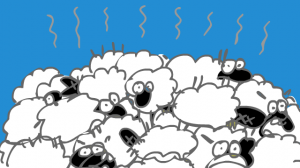
Rivalrous and non-rivalrous are often confused with scarce and abundant, but they’re not the same thing. Air is abundant, but it is still rivalrous – some “users” could make it toxic for the rest of us, because air is not infinite. Land and water are so abundant in North America that Native Americans couldn’t imagine owning or depleting them, and look what happened. We treat the oceans as infinite, but they are not; human pollution and exploitation is killing ocean life. We also pollute the vast ocean of air – hence acid rain. Air and oceans are commons.
Commons are commonly-held rivalrous goods. Because they are rivalrous, some uses (or over-use) can poison them or otherwise diminish their value. For that reason, Commons(es) actually merit rules and regulations.
But Culture is not a commons, because Culture is not rivalrous and can’t be owned.
II. Non-Rivalrous
Non-rivalrous goods, as their name implies, don’t diminish in value the more they are used. A favorite example of a non-rivalrous good is the light from a lighthouse. It shines for everyone. No matter how much you look at it, I can see it too.

This is a pretty good example, but it’s not quite right. Theoretically, if enough tall boats are in the harbor, they actually can crowd out your lighthouse light.

Consider sunlight in Manhattan; yes, the sun shines for everyone, but if they build a high-rise next to your apartment you won’t see it any more. There’s only so much sunlight that hits a certain area, and that light is rivalrous. You can always move, of course – except land, while abundant, is definitely rivalrous and not infinite, so you’ll have to engage in some rivalry to do so.
The light metaphor has another problem: is light a particle, or a wave? If it’s a particle, then light is rivalrous. If it’s a wave, then it’s not.
 Thomas Jefferson used the example of candle fire, writing “He who receives an idea from me, receives instruction himself without lessening mine; as he who lights his taper at mine, receives light without darkening me.” Of course candles burn out but it’s not the light that’s diminished, it’s the candle. That’s a great metaphor for attention, which is scarce: once our attention is used up, the light goes out.
Thomas Jefferson used the example of candle fire, writing “He who receives an idea from me, receives instruction himself without lessening mine; as he who lights his taper at mine, receives light without darkening me.” Of course candles burn out but it’s not the light that’s diminished, it’s the candle. That’s a great metaphor for attention, which is scarce: once our attention is used up, the light goes out.
 But Culture is not non-rivalrous either.
But Culture is not non-rivalrous either.
III. Anti-Rivalrous
Anti-rivalrous goods increase in value the more they are used. For example: language. A language isn’t much use to me if I can’t speak it with someone else. You need at least two people to communicate with language. The more people who use the language, the more value it has.
Which language do you think more people would pay to learn?
- English
- Esperanto
- Latvian
More people spend money and time learning English, simply because so many people already speak English.
Social networking platforms increase in value when more people use them. I use Facebook not because I love Facebook (I certainly don’t), but because everyone else uses Facebook. I just joined Google+, and will use that instead of Facebook if enough other people use it. If enough people flock to yet another platform, I’ll use that instead. Meanwhile I love Diaspora in principle (I was an early Kickstarter backer, before they surpassed their initial $ goal), but I don’t use it, because not enough other people do. When it comes to social networks, I am a sheep.
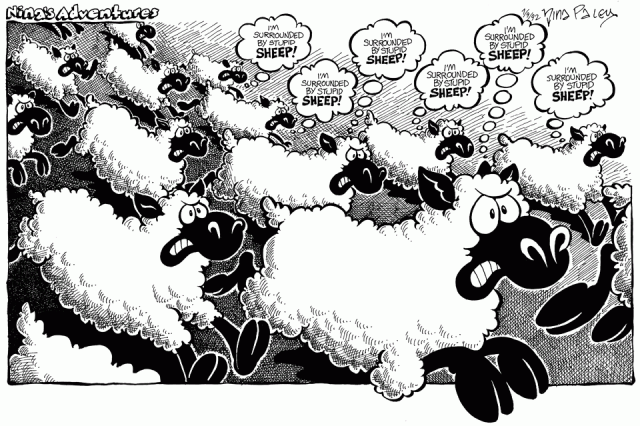
Culture is anti-rivalrous. The more people know and sing a song, the more cultural value it has. The more people watch my film Sita Sings the Blues, or read my comic strip Mimi & Eunice, the happier I’ll be, so please go do that now and then come back and read the rest of this paragraph. The more people know a movie or TV show, the more cultural value it has. Monty Python references attest to the cultural value of Monty Python – we even use the word “spam” because of it. Shakespeare‘s works are culturally valuable, and phrases from them live on in the language even apart from the plays (“I think she doth protest to much,” etc.). The more people refer to Monty Python and Shakespeare, the more you just gotta see em, amiright? Or not, it doesn’t matter whether you see them, you’re already speaking them. That all culture is a kind of language, I’ll leave for another discussion.
Cultural works increase in value the more people use them. That’s not rivalrous, or non-rivalrous; that’s anti-rivalrous.
IV. Some Exceptions That Prove The rule
I know what you’re gonna say now: “what about my credit card number? That doesn’t increase in value if it’s shared!!” That’s right, Einstein, because your credit card number is not culture. Here are two things that aren’t made of atoms and are nonetheless rivalrous:
1. Identity
2. Secrets
Identity is some mysterious mindfuck that my very smart friend Joe Futrelle says no one has satisfactorily defined yet. But whatever identity is, it’s rivalrous. If more people were named Nina Paley and had my home address and social security number, I’d be screwed. But that should highlight that my name, home address, and social security number aren’t culture. They may be information, but they’re not culture. They don’t increase in value the more they are used.
Secrets have power as long as they’re secrets. They lose their power when they are shared. When I become conscious of some secret that’s weighing on me, I share it with at least one other person (even if they are a confidante also sworn to secrecy): I can feel the secret’s power diffused just by the act of sharing. Notice I use “power” here instead of “value.” Secrets may be of little or no cultural value – most people don’t really care who that guy slept with 6 years ago – but they can certainly have power, especially when used for blackmail. Which is why it’s important they remain secrets, so they’re not used for blackmail, or harassment, or any reason at all. Privacy is important. Because secrets aren’t culture. Culture is public. Secrets are, well, secret. Until they’re public, whereupon we get scandalous stories that are culture – humans love to gossip – but aren’t secrets any more. The story might gain value, but the secret loses it.
Money vs. Currency
And how about money? Money is scarce, right? It has to be, or it doesn’t work (thanks Wall Street & Federal Reserve for screwing that up). But currency has more value the more it is used! Would you rather have your scarce 100 Euros in Euros, or in giant immoveable donut-like stones on a remote island?

I remember when the US dollar was a valuable currency; markets all over the world wanted dollars, because they were so widely used and exchangeable. So you want your money to be scarce, but you want your currency as widely used as possible.
V. Conclusion
It’s important to treat scarce goods as scarce, abundant goods as abundant, rivalrous goods as rivalrous, and so on. Wall Street treated money, a scarce and rivalrous good, as though it were infinite/non-rivalrous, and look what happened. Power companies, and the politicians they own, treat the environment, which is a rivalrous commons, as though it were non-rivalrous, and we have dying oceans and mass extinctions and other events you don’t want to think about so much that you’ll just get mad at me if I point them out here so I’ll stop. The RIAA and MPAA, and the politicians they own, treat Culture, which is anti-rivalrous, as though it’s rivalrous. They are doing for Culture what Wall Street did for the economy. If you want to help make this better, treat Culture like what it is: an anti-rivalrous good that increases in value the more it is used.
Addendum: Why do I say Culture is not a Commons?



